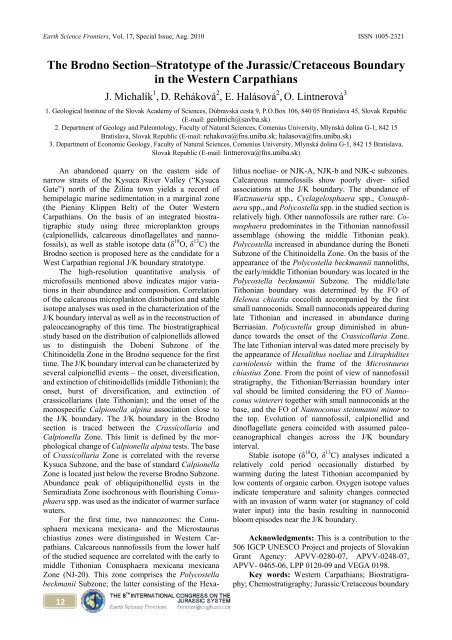in Jurassic and Cretaceous Stratigraphy
in Jurassic and Cretaceous Stratigraphy
in Jurassic and Cretaceous Stratigraphy
Create successful ePaper yourself
Turn your PDF publications into a flip-book with our unique Google optimized e-Paper software.
Earth Science Frontiers, Vol. 17, Special Issue, Aug. 2010 ISSN 1005-2321<br />
The Brodno Section–Stratotype of the <strong>Jurassic</strong>/<strong>Cretaceous</strong> Boundary<br />
<strong>in</strong> the Western Carpathians<br />
12<br />
J. Michalík 1 , D. Reháková 2 , E. Halásová 2 , O. L<strong>in</strong>tnerová 3<br />
1. Geological Institute of the Slovak Academy of Sciences, Dúbravská cesta 9, P.O.Box 106, 840 05 Bratislava 45, Slovak Republic<br />
(E-mail: geolmich@savba.sk)<br />
2. Department of Geology <strong>and</strong> Paleontology, Faculty of Natural Sciences, Comenius University, Mlynská dol<strong>in</strong>a G-1, 842 15<br />
Bratislava, Slovak Republic (E-mail: rehakova@fns.uniba.sk; halasova@fns.uniba.sk)<br />
3. Department of Economic Geology, Faculty of Natural Sciences, Comenius University, Mlynská dol<strong>in</strong>a G-1, 842 15 Bratislava,<br />
Slovak Republic (E-mail: l<strong>in</strong>tnerova@fns.uniba.sk)<br />
An ab<strong>and</strong>oned quarry on the eastern side of<br />
narrow straits of the Kysuca River Valley (“Kysuca<br />
Gate”) north of the Žil<strong>in</strong>a town yields a record of<br />
hemipelagic mar<strong>in</strong>e sedimentation <strong>in</strong> a marg<strong>in</strong>al zone<br />
(the Pien<strong>in</strong>y Klippen Belt) of the Outer Western<br />
Carpathians. On the basis of an <strong>in</strong>tegrated biostra-<br />
tigraphic study us<strong>in</strong>g three microplankton groups<br />
(calpionellids, calcareous d<strong>in</strong>oflagellates <strong>and</strong> nanno-<br />
fossils), as well as stable isotope data (δ 18 O, δ 13 C) the<br />
Brodno section is proposed here as the c<strong>and</strong>idate for a<br />
West Carpathian regional J/K boundary stratotype.<br />
The high-resolution quantitative analysis of<br />
microfossils mentioned above <strong>in</strong>dicates major varia-<br />
tions <strong>in</strong> their abundance <strong>and</strong> composition. Correlation<br />
of the calcareous microplankton distribution <strong>and</strong> stable<br />
isotope analyses was used <strong>in</strong> the characterization of the<br />
J/K boundary <strong>in</strong>terval as well as <strong>in</strong> the reconstruction of<br />
paleoceanography of this time. The biostratigraphical<br />
study based on the distribution of calpionellids allowed<br />
us to dist<strong>in</strong>guish the Dobeni Subzone of the<br />
Chit<strong>in</strong>oidella Zone <strong>in</strong> the Brodno sequence for the first<br />
time. The J/K boundary <strong>in</strong>terval can be characterized by<br />
several calpionellid events – the onset, diversification,<br />
<strong>and</strong> ext<strong>in</strong>ction of chit<strong>in</strong>oidellids (middle Tithonian); the<br />
onset, burst of diversification, <strong>and</strong> ext<strong>in</strong>ction of<br />
crassicollarians (late Tithonian); <strong>and</strong> the onset of the<br />
monospecific Calpionella alp<strong>in</strong>a association close to<br />
the J/K boundary. The J/K boundary <strong>in</strong> the Brodno<br />
section is traced between the Crassicollaria <strong>and</strong><br />
Calpionella Zone. This limit is def<strong>in</strong>ed by the mor-<br />
phological change of Calpionella alp<strong>in</strong>a tests. The base<br />
of Crassicollaria Zone is correlated with the reverse<br />
Kysuca Subzone, <strong>and</strong> the base of st<strong>and</strong>ard Calpionella<br />
Zone is located just below the reverse Brodno Subzone.<br />
Abundance peak of obliquipithonellid cysts <strong>in</strong> the<br />
Semiradiata Zone isochronous with flourish<strong>in</strong>g Conus-<br />
phaera spp. was used as the <strong>in</strong>dicator of warmer surface<br />
waters.<br />
For the first time, two nannozones: the Conu-<br />
sphaera mexicana mexicana- <strong>and</strong> the Microstaurus<br />
chiastius zones were dist<strong>in</strong>guished <strong>in</strong> Western Car-<br />
pathians. Calcareous nannofossils from the lower half<br />
of the studied sequence are correlated with the early to<br />
middle Tithonian Conusphaera mexicana mexicana<br />
Zone (NJ-20). This zone comprises the Polycostella<br />
beckmanii Subzone; the latter consist<strong>in</strong>g of the Hexa-<br />
lithus noeliae- or NJK-A, NJK-b <strong>and</strong> NJK-c subzones.<br />
Calcareous nannofossils show poorly diver- sified<br />
associations at the J/K boundary. The abundance of<br />
Watznaueria spp., Cyclagelosphaera spp., Conusph-<br />
aera spp., <strong>and</strong> Polycostella spp. <strong>in</strong> the studied section is<br />
relatively high. Other nannofossils are rather rare. Co-<br />
nusphaera predom<strong>in</strong>ates <strong>in</strong> the Tithonian nannofossil<br />
assemblage (show<strong>in</strong>g the middle Tithonian peak).<br />
Polycostella <strong>in</strong>creased <strong>in</strong> abundance dur<strong>in</strong>g the Boneti<br />
Subzone of the Chit<strong>in</strong>oidella Zone. On the basis of the<br />
appearance of the Polycostella beckmannii nannoliths,<br />
the early/middle Tithonian boundary was located <strong>in</strong> the<br />
Polycostella beckmannii Subzone. The middle/late<br />
Tithonian boundary was determ<strong>in</strong>ed by the FO of<br />
Helenea chiastia coccolith accompanied by the first<br />
small nannoconids. Small nannoconids appeared dur<strong>in</strong>g<br />
late Tithonian <strong>and</strong> <strong>in</strong>creased <strong>in</strong> abundance dur<strong>in</strong>g<br />
Berriasian. Polycostella group dim<strong>in</strong>ished <strong>in</strong> abun-<br />
dance towards the onset of the Crassicollaria Zone.<br />
The late Tithonian <strong>in</strong>terval was dated more precisely by<br />
the appearance of Hexalithus noeliae <strong>and</strong> Litraphidites<br />
carniolensis with<strong>in</strong> the frame of the Microstaurus<br />
chiastius Zone. From the po<strong>in</strong>t of view of nannofossil<br />
stratigraphy, the Tithonian/Berriasian boundary <strong>in</strong>ter<br />
val should be limited consider<strong>in</strong>g the FO of Nanno-<br />
conus w<strong>in</strong>tereri together with small nannoconids at the<br />
base, <strong>and</strong> the FO of Nannoconus ste<strong>in</strong>manni m<strong>in</strong>or to<br />
the top. Evolution of nannofossil, calpionellid <strong>and</strong><br />
d<strong>in</strong>oflagellate genera co<strong>in</strong>cided with assumed paleo-<br />
ceanographical changes across the J/K boundary<br />
<strong>in</strong>terval.<br />
Stable isotope (δ 18 O, δ 13 C) analyses <strong>in</strong>dicated a<br />
relatively cold period occasionally disturbed by<br />
warm<strong>in</strong>g dur<strong>in</strong>g the latest Tithonian accompanied by<br />
low contents of organic carbon. Oxygen isotope values<br />
<strong>in</strong>dicate temperature <strong>and</strong> sal<strong>in</strong>ity changes connected<br />
with an <strong>in</strong>vasion of warm water (or stagnancy of cold<br />
water <strong>in</strong>put) <strong>in</strong>to the bas<strong>in</strong> result<strong>in</strong>g <strong>in</strong> nannoconid<br />
bloom episodes near the J/K boundary.<br />
Acknowledgments: This is a contribution to the<br />
506 IGCP UNESCO Project <strong>and</strong> projects of Slovakian<br />
Grant Agency: APVV-0280-07, APVV-0248-07,<br />
APVV- 0465-06, LPP 0120-09 <strong>and</strong> VEGA 0198.<br />
Key words: Western Carpathians; Biostratigra-<br />
phy; Chemostratigraphy; <strong>Jurassic</strong>/<strong>Cretaceous</strong> boundary

















